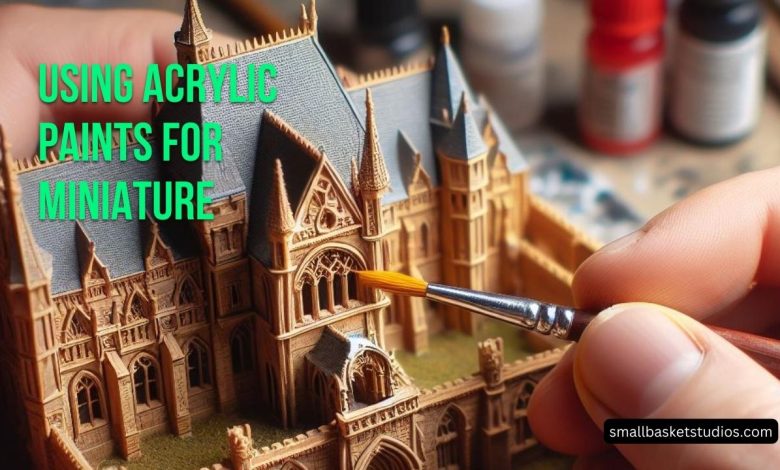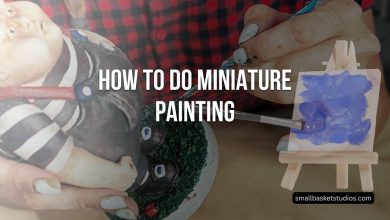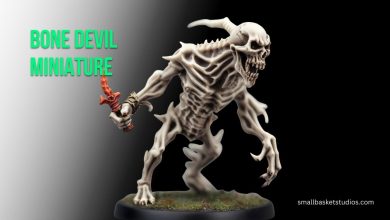Can You Use Acrylic Paint for Miniatures? A Professional’s Perspective

From historical war figurines to intricate fantasy worlds in a bottle, creative hobbyists love crafting handmade miniatures showcasing their artistic vision and skill. But what about paint? Can standard acrylic craft paints adequately coat tiny details on such a small scale? The quick answer – yes! When properly thinned and applied, versatile acrylics readily tackle any miniature painting project. This comprehensive guide covers everything needed to harness acrylic’s potential for painting stunning mini creations that last.
The Complete Guide to Using Acrylic Paints for Miniature Models
Why Acrylics Work for Miniature Painting Miniatures span many genres, from model trains and decorative Christmas villages to detailed dungeons and dragons’ gaming figures. But the central challenge remains consistent – precise painting on an impossibly small scale. Why turn to acrylics instead of oils, enamels or other media to meet this need? Acrylic’s strengths stack the deck in its favor…
Advantages of Acrylic Paint for Miniatures:
- Thins Smoothly – Flows into microscopic crevices easily
- Dries Quickly – Work fast with no wait between coats
- Water-Clean Up – No smelly chemicals or solvents
- Non-Toxic – Critical for playsets and child interaction
- Vivid Finishes – Bright lasting colors on par with costlier paints
The control afforded by proper thinning paired with quick-drying convenience allows painters to build stunning depth, dimension and vibrancy – critical in smaller scaled work. Let’s delve into professional techniques leveraging these inherent benefits.
Choosing Your Acrylic Paints

Walk down any art supply aisle and you’ll encounter a spectrum of acrylic paint options. At first glance, basic grades provide every needed color at a fraction of the cost of professional quality paints. Yet higher pigmentation concentrated in artist quality acrylics create superior covering potential with improved flow for miniature work. Choosing the right selection matters…
Artist Quality Acrylics Hobby/Craft Acrylics
- Less Quantity for More Pigment • More Fillers Weaken Coverage
- Smooth Flow from Finer Pigments • Chalkier Texture Obscures Detail
- Richer, Truer Colors • Cheaper But Higher Waste The higher content of concentrated pigment packed into professional acrylics produces richer color consistency across repeated thin coats – imperative for miniatures.
Getting Specific: The Best Paint Brands
Not all artist quality acrylic brands perform the same. For miniatures, leading choices like Liquitex, Golden, Winsor & Newton and Vallejo Model Color excel. Their formulations offer:
- Unrivaled Pigment Quality + Concentration
- Smoother Flow With Self-Leveling Properties
- Exceptional Durability + UV Resistance
- Broad, Intermixable Color Ranges
While more premium-priced than poor quality hobby paints, professional acrylics’ superior composition reduces waste, better optimizing your investment – especially for miniature work requiring careful color blending.
Thinning Acrylic Paint for Detailing Work
Here’s where acrylic’s greatest advantage shines. Water-thinnability… Unlike enamels needing chemical reducers, acrylics employ water for easy, safe viscosity control. By tweaking consistency, painters inject life into miniatures as light realistically reflects around downsized crevices and contours.

Thinning Approaches Include:
- Wet Palette – Acrylic glazes flow smoothly with even drying
- Water Misting – Direct a mister near surface just before or after applying paint. The moisture gently “feathers” edges, creating subtle blending.
- Oil Painting Medium – Increases flow and levels surface imperfections
- Airbrush Diluent Additives – Enhances spray-ability
Start with small amounts of water or medium to prevent over-thinning. Too much movement produces muddy, obscured details in miniatures. The goal is just enough flow to surround the tiniest intricacies.
Textures, Washes and Special Effects
Beyond standard color application, acrylics unlock boundless creative potential for miniatures…
Interesting Textures:
- Dry brushing – Build depth with ragged wood grain, stone, foliage or fur textures
- Palette Knife Painting – Use actual miniature tools to sculpt on peaks of thick gel paint
- Sand & Straw Inclusions – Glue on textural elements after painted base dries
Eye-Catching Washes:
- Contrasting Stains – Yellowed ivory, blue-tinted black, fluorescent washes
- Metallic Sheens – Mix-in glistening mica powders or metal leafing
- Camouflage Variegation – Create tonal, translucent filtering effects like sun-dappled water
Special Finishing Effects:
- Crackle Mediums – Apply over base coats to mimic aged, weathered surfaces
- Decal Transfers – Insert tiny warning labels, control panels, signage and more
- Rhinestones & Decals – Affix for fantasy or holiday sparkle
Acrylic’s quick-drying flexibility keeps the creative process moving. Unlike oils, moving fast prevents unnecessary wait times between steps. And thinner consistency penetrates deeper into miniature recesses than goopy paint. This broadens colorful possibilities within the delicate brushwork needed for precision detailing.
Top Miniature Painting Techniques
Skills mastered painting on canvas or larger models translate easily when sized down using acrylics. But additional precision comes into play for miniatures’ micro details. Use these techniques to maximize realism:
- Prime Surfaces First – Creates tooth and uniformity between materials
- Thin Layers – Sheer veils reveal depths while preventing obscured detail
- Drybrush Weathering – Add realistic wear and age marks over base coats
- Wet Blending – Softening edges creates realistic gradients
- Glazing – Translucent layers produce multi-dimensional luminous effects
- Photo References – Study real life objects/textures closely to reproduce qualities
Acrylic’s quick dry time affords working numerous layered effects fast – important for drifting techniques before unwanted drying begins mid-process. Compared to unpredictable blending with oils or enamels, acrylic is more forgiving to start. Wiping away mistakes doesn’t require pungent thinners – just soap and water. Yet when mastered, acrylic creates equally stunning illumination replicas as costlier media.
Clear Coating and Protecting Finishes
Left unprotected, acrylic paint remains susceptible to chipping, fingerprints and fading over time – amplified on frequently handled miniatures. Prevent paint damage after all that meticulous work with a clear sealer. Quick-dry choices like brush-on varnish or acrylic spray sealants protect paint integrity while maintaining realistic light refraction. Matte, satin or gloss finishes suit any genre from military models to decorative Christmas villages.
Before sealing, ensure paint fully cures first – usually 24 hours. Trapped solvents or moisture risk clouding clear coats. With proper sealing, acrylic paint endures, preserving miniature artistry for generations.
Frequently Asked Questions
What acrylic paint works best for painting miniatures and models?
Professional quality acrylics like Liquitex, Vallejo and Golden yield optimum coverage consistency, realism and durability for painting miniatures versus cheaper craft store acrylics.
Should I hand paint or airbrush acrylic onto miniatures?
Hand painting allows great control for precision detailing miniatures. Airbrushes excel at general background color gradients and broad effects but can overwhelm extremely fine features. Combine both!
What basic colors should my miniature painting acrylic collection include?
At minimum, collect primary colors (red, blue, yellow) plus black, white and burnt umber. This provides mixing versatility for any basic subject’s skin tones, shading and highlights.
How do I thin down acrylic paint for best miniature coverage?
Add a little water or acrylic thinning medium and mix until reaching the ideal consistency that flows smoothly but holds precision lines and opacity. Too much thinning risks muddytransparency.
Can I use acrylic paint on polymer clay or resin miniatures?
Yes! Acrylics bond well to properly cured and primed polymer clay or resin. Ensure pieces completely finished curing first or paint risks peeling off over time as materials off-gas.
Acrylic’s innate flexibility makes it the perfect introductory paint for aspiring miniature artists while meeting professionals’ sophisticated needs for replicating life through meticulously scaled models. Follow fundamental techniques to leverage acrylic’s versatile potential for creating long-lasting mini masterpieces.




